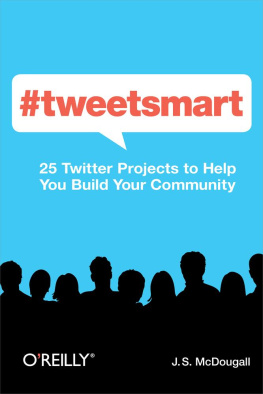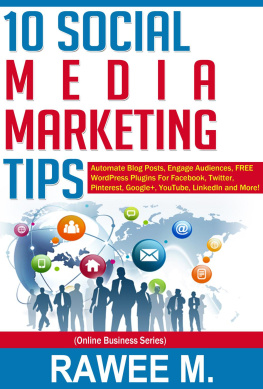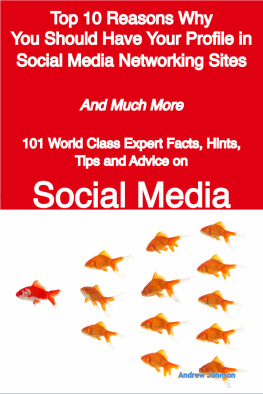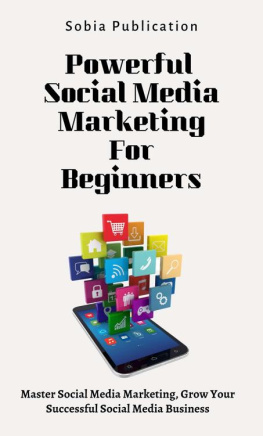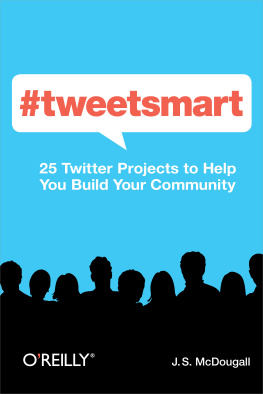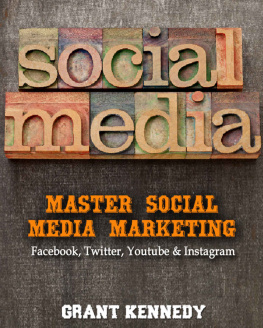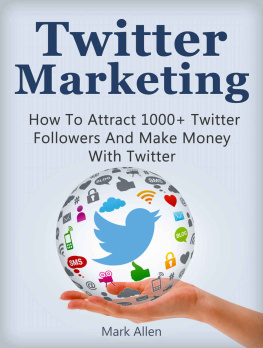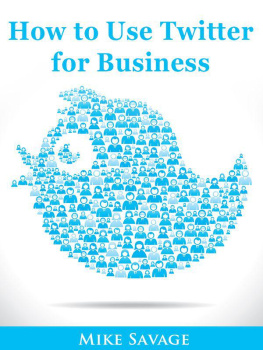Introduction
At nearly every conference I attend, I meet people who tell me, I have no use for Twitter. You cant say anything in 140 characters. Id rather have a real conversation. Obviously, as Im the one writing this book, I feel differently. So, to all the doubters and skeptics, I offer the following story:
My grandfather, Mac McDougalllike so many grandparentsmoved to Florida when it came time for him to retire. His neighborhood was a flat rectangle, carved out of fields of orange groves, and tucked in beside a maze of golf courses. His street was a flat street in a grid of flat streets. His house was a single-level brown adobe home in a row of single-level brown adobe homes. At the end of his driveway was a green mailbox. At the end of every driveway wasa green mailbox.
We would visit him nearly every winter. Wed often drive the long journey down I-95 from New Hampshire to Florida, and 24 hours after climbing into the vanas my dad drove the van through the flat streetsI would see my grandfathers house. Even as a small child, I had an easy time picking out his house from all the rest. His was the only one with a 50-foot radio tower standing in the backyard.
My grandfather was a ham radio operator. He had received his operators license in 1930 when he was just 15 years old. As a teenager, he taught himself how to build his own radios out of spare parts. He then served during WWII in a communications unit, and after the war he continued to communicate with other hammers all over the world. Upon retirement, he moved to this adobe home and set up his own radio roomcomplete with a radio tower outside his window.
In the late evenings during our visits, he would excuse himself and shuffle to his radio room for his weekly appointments with his radio buddies. Sometimes Id sit beside himmarveling at the knobs and lights all around the cluttered roomwhile he tapped out his messages in Morse code, laughed, and waited in anticipation for the beeps and boops that would reply.
Oh marvelous! hed say. Janice had her baby!
Ibeing sixdidnt know Janice and didnt care much that shed had her baby. But I could watch for hours as these sporadic beeps and boops somehow triggered outbursts of joy and happy tears from my grandfather.
I would learn many years later that my grandfather was speaking to a man in New Zealand named John. They met over the airwaves and quickly became friendstapping back and forth to each other about their love of radios, golf, and the additions to their families.
Every week my grandfather would shuffle down the hall in the late evenings for his scheduled chat with John whoat that same timewas shuffling out of bed to start his day in New Zealand.
When my grandfather passed away in 2007, it had been over twenty years since I last sat with him in his radio room. At the time of his death he held the longest continuously-active ham radio operator license in the United States77 years.
In a long procession on a sad day, we drove down the flat streetspast the orange groves and golf coursesto the funeral home. Family and friends filled the room, many of whom I hadnt seen in years and many of whom Id never met. And, in introducing myself to some of the folks, I met a small white-haired man who stood alone at the back of the room. Hello, he said in a funny accent. Im John.
Real relationships have been built on forms of communication offering far fewer than 140 characters. The human animal is capable of extracting real and meaningful information from countless forms of communicationwhether its Morse code, or a wink, a nervous foot, a billboard, or even a tweet.
The content of your communication is importantnot what carries it.
What This Book Is
This book is my answer to anyone who has ever asked the question, OK. Ive got my Twitter accountnow what do I do? In the following pages I have created 25 Twitter projects that will help you approach your Twitter community engagement efforts in a way that is strategic, fun, and measurable.
Too often people come up to me and say, I set up my Twitter account. I was on there for a few weeks, andit didnt really work. The rise of the planets social media frenzy has spilled over into the business world. This frenzy has created a feeling in business owners and marketers that they need to be everywhere at once, all the time. This is crazy. People often create accounts on every new social media site that pops up, spend what precious little time they have in their day poking at it, and then leaving the account for dead when there are no immediate results. Its a common problemand, being a small business owner myself, its one with which I sympathize.
Consider this book your Time out!
The solution to this frenzied overexposure is not the automation of all 50 of your accounts. And the solution is not to work harder to try to keep up with all of them. To be effective at building an engaged community, businesses must slow down and work smarter.
Using focus, research, and a little strategy throughout your social media efforts, you will finally begin to see (and measure) some impressive results. The projects in this book will help you get started, butin the endI hope these are just training tools that will help you learn the elements of a successful campaign, and how to create campaigns all your own.
What This Book Is Not
This book is not a social media marketing manual. In fact, I shudder whenever I hear or use the phrase social media marketing. It just sounds slimy, doesnt it? Twitter is not a marketing channeland you should never view it as such.
These 25 projects are not marketing projects. They are community-building projects. The goal of each of the following projects is to build an interested and engaged community for your business. The payoff that comes from having such a community around your business is increased sales, referrals, and opportunities for feedback and improvement. It is vital to understand the difference between your goal and your payoff.

